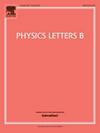来自风味依赖相互作用的重-轻介子
IF 4.5
2区 物理与天体物理
Q1 ASTRONOMY & ASTROPHYSICS
引用次数: 0
摘要
我们引入了重-轻介子物理学的一个新框架,其关键要素是将风味依赖的贡献有效地纳入相应的束缚态和夸克间隙方程。这些术语源于这些方程核心中出现的完全修饰的夸克-胶子顶点,并提供了“轻”和“重”夸克之间的自然区别。在这种方法中,只保留了夸克-胶子顶点的经典形状因子,并在所谓的“对称”配置中进行评估。标准的斯拉夫诺夫-泰勒恒等式将这种形式因素与夸克波函数联系起来,允许从轻夸克到重夸克的连续转换,仅仅通过间隙方程中当前夸克质量的变化。用该方法计算了特定赝标量和矢量重-轻体系的质量和衰变常数,与实验数据和晶格模拟结果基本吻合。本文章由计算机程序翻译,如有差异,请以英文原文为准。
Heavy-light mesons from a flavour-dependent interaction
We introduce a new framework for the physics of heavy-light mesons, whose key element is the effective incorporation of flavour-dependent contributions into the corresponding bound-state and quark gap equations. These terms originate from the fully-dressed quark-gluon vertices appearing in the kernels of these equations, and provide a natural distinction between “light” and “heavy” quarks. In this approach, only the classical form factor of the quark-gluon vertex is retained, and is evaluated in the so-called “symmetric” configuration. The standard Slavnov-Taylor identity links this form factor to the quark wave-function, allowing for the continuous transition from light to heavy quarks through the mere variation of the current quark mass in the gap equation. The method is used to compute the masses and decay constants of specific pseudoscalars and vector heavy-light systems, showing good overall agreement with both experimental data and lattice simulations.
求助全文
通过发布文献求助,成功后即可免费获取论文全文。
去求助
来源期刊

Physics Letters B
物理-物理:综合
CiteScore
9.10
自引率
6.80%
发文量
647
审稿时长
3 months
期刊介绍:
Physics Letters B ensures the rapid publication of important new results in particle physics, nuclear physics and cosmology. Specialized editors are responsible for contributions in experimental nuclear physics, theoretical nuclear physics, experimental high-energy physics, theoretical high-energy physics, and astrophysics.
 求助内容:
求助内容: 应助结果提醒方式:
应助结果提醒方式:


